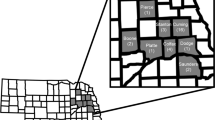Abstract
The Vip3A, a vegetative Bacillus thuringiensis (Bt) gene, has been introduced into many Cry maize and cotton varieties that can manage the recently occurred Cry1/Cry2 resistance in Noctuidae pests including Helicoverpa zea (Boddie) in the USA. A seed blend refuge has been used for providing susceptible insect populations for Bt maize resistance management. Four field trials were deployed in this study to investigate the effects of Bt protein contamination due to gene flow in seed blend refuges of Viptera maize containing Cry1Ab and Vip3Aa20 genes with 0–30% refuges on the survival, development, and reproduction of the parental and F1 generations of H. zea. Viptera maize is highly effective against H. zea and likely expresses a ‘high dose’ for the insect. Compared to the survival on the structured refuge, seed blends reduced approximately 70% of the pupal and adult productions from refuge ears, and the reductions were not related to the refuge percentage. Pupae from the seed blend refuge weighed 22.1% less than those from the structured refuge, but the body mass reduction did not significantly affect the reproduction per female. All field populations were highly resistant to Cry1Ab, but susceptible to Vip3Aa20. Fitness of the F1 generations from the structured and seed blend refuges in diet rearing was generally similar. Data generated from the study can be used in simulation modeling to evaluate the feasibility of seed blends for resistance management.
Similar content being viewed by others
References
Andow DA (2008) The risk of resistance evolution in insects to transgenic insecticidal crops. ICGEB Collect Biosaf Rev 4:142–199
Bernardi D, Salmeron E, Horikoshi RJ, Bernardi O, Dourado PM, Carvalho RA, Martinelli S, Head GP, Omoto C (2005) Cross-resistance between Cry1 proteins in fall armyworm (Spodoptera frugiperda) may affect the durability of current pyramided Bt maize hybrids in Brazil. PLoS ONE 10:e0140130
Bilbo TR, Reay-Jones FPF, Reisig DD, Greene JK, Turnbull MW (2019) Development, survival, and feeding behavior of Helicoverpa zea (Lepidoptera: Noctuidae) relative to Bt protein concentrations in corn ear tissues. PLoS ONE 14(8):e0221343. https://doi.org/10.1371/journal.pone.0221343
Buntin GD (2008) Corn expressing Cry1Ab or Cry1F endotoxin for fall armyworm and corn earworm (Lepidoptera: Noctuidae) management in field corn for grain production. Florida Entomol 91:523–530
Buntin GD, Lee RD, Wilson DM, McPherson RM (2000) Evaluation of YieldGard transgenic resistance for control of fall armyworm and corn earworm (Lepidoptera: Noctuidae) on corn. Florida Entomol 84:37–42
Burkness EC, Dively G, Patton T, Morey AC, Hutchison WD (2010) Novel Vip3A Bacillus thuringiensis (Bt) maize approaches high-dose efficacy against Helicoverpa zea (Lepidoptera: Noctuidae) under field conditions. GM crop 1:1–7
DiFonzo C (2020) The handy Bt trait table for U.S. corn production. https://agrilife.org/lubbock/files/2020/02/BtTraitTable_FEB_2020.pdf
Dimase M, Oyediran I, Brown S, Walker W, Guo J, Yu W, Huang F (2020) Larval movement and survival of Helicoverpa zea (Boddie) in seed blends of non-Bt and Bt corn containing Agrisure Viptera®trait: implications for resistance management. Crop Protect 138:105339. https://doi.org/10.1016/j.cropro.2020.105339
Dively GP, Huang F, Oyediran I, Burd T, Morsello S (2020) Evaluation of gene flow in structured and seed blend refuge systems of non-Bt and Bt corn. J Pest Sci 93:439–447
Estruch JJ, Warren GW, Mullins MA, Nye GJ, Craig JA, Koziel MG (1996) Vip3A, a novel Bacillus thuringiensis vegetative insecticidal protein with a wide spectrum of activities against lepidopteran insects. Proc Natl Acad Sci USA 93:5389–5394
FIFRA Scientific Advisory Panel (1998) Report of subpanel on Bacillus thuringiensis (Bt) plant-pesticides and resistance management. EPA SAP Report. http://www.mindfully.org/GE/FIFRA-SAP-Bt.htm. Accessed Feb 9,1998
Guo J, Yang F, Brown S, Kern D, Head GP, Price PA, Niu Y, Huang F (2019) Fecundity of the parental and fitness of the F1 populations of corn earworm from refuge ears of seed blend plantings with Genuity® SmartStax maize. Crop Protect 124:1–4. https://doi.org/10.1016/j.cropro.2019.104873
Hernández-Rodríguez CS, Hernández-Martínez P, Van Rie J, Escriche B, Ferré J (2013) Shared midgut binding sites for Cry1A.105, Cry1Aa, Cry1Ab, Cry1Ac and Cry1Fa proteins from Bacillus thuringiensis in two important corn pests, Ostrinia nubilalis and Spodoptera frugiperda. PLoS ONE 8:e68164
Horner TA, Dively GP, Herbert DA (2003) Development, survival and fitness performance of Helicoverpa zea (Lepidoptera: Noctuidae) in MON810 Bt field corn. J Econ Entomol 96:914–924
Huang F (2020a) Resistance of the fall armyworm Spodoptera frugiperda (F.), to transgenic Bacillus thuringiensis Cry1F corn in the Americas: lessons and implications for Bt corn IRM in China. Ins Sci. https://doi.org/10.1111/1744-7917.12826
Huang F (2020b) Dominance and fitness costs of insect resistance to genetically modified Bacillus thuringiensis crops. GM Crops & Food: Biotechnology in Agriculture and the Food Chain. https://doi.org/10.1080/21645698.2020.1852065
Huang F, Andow DA, Buschman LL (2011) Success of the high-dose/refuge resistance management strategy after 15 years of Bt crop use in North America. Entomol Exp Appl 140:1–16
SAS Institute (2010) SAS/STAT: 9.3 User's Guide, third ed. SAS Institute Inc., Cary, NC
Kaur G, Guo J, Brown S, Head GP, Price PA, Paula-Moraes S, Ni X, Dimase M, Huang F (2019) Field-evolved resistance of Helicoverpa zea (Boddie) to transgenic maize expressing pyramided Cry1A.105/Cry2Ab2 proteins in northeast Louisiana, the United States. J Invertebr Pathol 163:11–20
Lee MK, Walters FS, Hart H, Palekar N, Chen JS (2003) The mode of action of the Bacillus thuringiensis vegetative insecticidal protein Vip3A differs from that of Cry1Ab delta-endotoxin. Appl Microbiol Biotechnol 69:4648–4657
Matten SR, Frederick RJ, Reynolds AH (2012) United States environmental protection agency insect resistance management programs for plant-incorporated protectants and use of simulation modeling. In: McHughen A (ed) Wozniak CA. Regulation of agricultural biotechnology, The United States and Canada. Springer, pp 175–267
Paula DP, Andow DA, Timbo RV, Sujii ER, Pires CSS, Fontes EMG (2014) Uptake and transfer of a Bt toxin by a lepidoptera to its eggs and effects on its offspring. PLoS ONE 9(4):e95422. https://doi.org/10.1371/journal.pone.0095422
Reay-Jones FPF (2019) Pest status and management of corn earworm (Lepidoptera: Noctuidae) in field corn in the United States. J Integr Pest Manag 10:1–9
Reisig DD, Reay-Jones FPF (2015) Inhibition of Helicoverpa zea growth by transgenic corn expressing Bt toxins. Environ Entomol 44:1275–1285
Santos-Amaya OF, Rodrigues JV, Souza TC, Tavares CS, Campos SO, Guedes RN, Pereira EJ (2015) Resistance to dual-gene Bt maize in Spodoptera frugiperda: selection, inheritance, and cross-resistance to other transgenic events. Sci Rep 5:18243
Tabashnik BE, Carrière Y (2019) Global patterns of resistance to Bt crops highlighting pink bollworm in the United States, China, and India. J Econ Entomol 112:2513–2523
US-EPA (United States Environmental Protection Agency) (2018) White Paper on Resistance in Lepidopteran Pests of Bacillus thuringiensis (Bt) Plant Incorporated Protectants in the United States. https://www.epa.gov/sites/production/files/2018-07/documents/position_paper_07132018.pdf. Accessed 7 July, 2020.
Yang F, Kerns DL, Leonard BR, Oyediran I, Burd T, Niu Y, Huang F (2015) Performance of Agrisure® Viptera 3111 corn against Helicoverpa zea (Lepidoptera: Noctuidae) in seed mixed plantings. Crop Protect 69:77–82
Yang F, Kerns DL, Head GP, Price PA, Levy R, Niu Y, Huang F (2020) Extended evaluation of Bt protein cross pollination in seed mix plantings on survival, growth, and development of Helicoverpa zea feeding on refuge ears. Pest Manag Sci 76:1011–1019
Yang F, González JCS, Little N, Reisig D, Payne G, Dos Santos RF, Jurat-Fuentes JL, Kurtz R, Kerns DL (2020) First documentation of major Vip3Aa resistance alleles in field populations of Helicoverpa zea (Boddie) (Lepidoptera: Noctuidae) in Texas. Sci Rep, USA. https://doi.org/10.1038/s41598-020-62748-8
Acknowledgements
This publication has been approved by the Associate Vice President & Program Leader of the Louisiana State University Agricultural Center (LSU AgCenter) as manuscript No. 2020-234-34768. This paper reports research results only. Mention of a proprietary product name does not constitute an endorsement for its use by LSU AgCenter.
Funding
Partial support was provided by Syngenta Biotechnology (RTC, NC, USA), along with internal support from Department of Entomology, LSU AgCenter.
Author information
Authors and Affiliations
Contributions
MER, IO, and FH conceived and designed the research. JG, SB, MD, SL, WY, and FH conducted the experiments. JG and FH analyzed the data and drafted the manuscript. All authors read, revised and approved the manuscript.
Corresponding author
Ethics declarations
Conflict of interest
FH received research supports from Syngenta Biotechnology for other related studies. The authors declare that they have no conflict of interest.
Ethical approval
This article does not contain any studies with human participants or animals performed by any of the authors.
Additional information
Communicated by Sharon Downes.
Publisher's Note
Springer Nature remains neutral with regard to jurisdictional claims in published maps and institutional affiliations.
Rights and permissions
About this article
Cite this article
Guo, J., Oyediran, I., Rice, M.E. et al. Seed blends of pyramided Cry/Vip maize reduce Helicoverpa zea populations from refuge ears. J Pest Sci 94, 959–968 (2021). https://doi.org/10.1007/s10340-020-01307-6
Received:
Revised:
Accepted:
Published:
Issue Date:
DOI: https://doi.org/10.1007/s10340-020-01307-6




